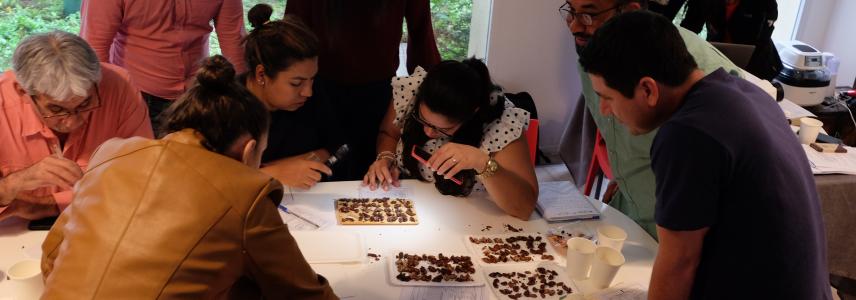A taste for cocoa

In order for cocoa producers in Central America to capitalise on a growing niche market for fine-flavoured cocoa products, education amongst producers around the complex organoleptic properties of the product is necessary. To help achieve this, CBI facilitated training workshops on November 1st and 2nd, 2019 under the Market Orientation Mission for cocoa participants from Central America.
Central American tradition
The love for cocoa and chocolate began some 5000 years ago, in Mesoamerica, and the plant was most probably introduced from the Amazon basin. Cocoa was cultivated in Mesoamerica, which extended from Mexico to present-day Central America, and the ancient civilizations of Central America, such as the Aztecs and Mayans, endowed the product with great culinary, cultural and spiritual significance. It became such a valuable commodity that it was used as currency.
Although the origins of chocolate lie in Latin America, today, over 70 per cent of cocoa production takes place in West Africa. Nonetheless, the crop and its derivative product, chocolate, is gaining popularity again in Central America. Cocoa producers in Central America are often organized in collectives or cooperatives and, in most cases, they are dedicated to subsistence agriculture, with low yields in cocoa crops. Various varietals of cocoa are grown in the region, with Criollo being the most ancient variety and renowned for its flavour. In recent years, new cultivars have been established by cloning of genotypes through grafting, with the objective of modernising old plantations and improving the productivity of the region.
Increasing demand for fine flavour cocoa
The demand for fine flavour cocoa and chocolate in Europe is growing continually. Fine flavour cocoa is a niche market, in which small quantities of higher-value and quality cocoa is traded. Consumers are developing a taste for more refined flavours. Fine flavour cocoa is often combined with single-origin and bean-to-bar concepts. Direct trade is a growing channel for fine flavour cocoa beans, resulting in closer interactions between cocoa growers and food product manufacturers. Prices for fine flavour cocoa can be up to two- or three times higher than that of bulk cocoa. This provides good opportunities for Central American exporters, as their cocoa is often characterised as ‘nutty’ and ‘floral’.
A niche market in need of sensorial evaluation techniques
Cocoa is a product, with sensory and organoleptic attributes, that depends on quality control and post-harvest processes such as fermentation and drying. To help the Central American cocoa sector to progress, the sensory skills needed to assess and improve quality through flavour and to market fine cocoa through its flavour and cocoa profiles must be acquired. Understanding how different senses inform about the product, recognising post-harvest defects and understanding cocoa profiles will help Central American producers and exporters to capitalise on opportunities in the fine flavour export market.
Within the framework of the ‘Connecting Central America’ initiative, which is primarily financed by the European Union and coordinated by SIECA, CBI organised a workshop on the 1st and 2nd of November 2019, to train the participants on the basic topics for cocoa and chocolate tasters and on implementation of the methodology used in sensorial evaluation of cocoa and chocolate. The participants of the training will go on to use and promote the knowledge they have gained, setting up local tasting panels in their respective countries. The training was carried out by Nubia Martinez, aligned to the National Agrarian University of La Molina, in Lima, Peru and member of the Cocoa of Excellence Technical Committee. CBI intends to continue with the training and standardisation of tasters, protocols and standards for the improvement of the quality of cocoa and chocolate in the Central American region.
Connecting Central America
The ‘Connecting Central America’ initiative aims to support 60 small- and medium-sized enterprises (SMEs) and cooperatives from Central America, between 2018 and 2021, to become more competitive in the European marketplace. The initiative is focused on the sectors of speciality coffee, cocoa and derivatives, fresh fruits and vegetables, and fish and seafood.
The initiative forms part of the Central American Regional Economic Integration (INTEC) project. INTEC is a project financed primarily by the European Union and coordinated by SIECA which aims at strengthening the economic integration in Central America (CA) and maximising the benefits of the implementation of the Association Agreement signed between the European Union and Central America.
For further information, please visit https://www.cbi.eu/projects/connecting-central-america/.